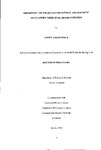ABSORPTION AND UTILISATION OF NATURAL AND SYNTHETIC ASTAXANTHIN FORMS IN SALMONID NUTRITION
| dc.contributor.author | WHITE, DANIEL ALLAN | |
| dc.contributor.other | Faculty of Science and Engineering | en_US |
| dc.date.accessioned | 2013-10-23T08:24:26Z | |
| dc.date.available | 2013-10-23T08:24:26Z | |
| dc.date.issued | 2001 | |
| dc.identifier | NOT AVAILABLE | en_US |
| dc.identifier.uri | http://hdl.handle.net/10026.1/2297 | |
| dc.description.abstract |
Consumer preference for commercially reared fish products that resemble their wild counterparts has resulted in the supplementation of pigments called carotenoids into aquafeeds to promote a pink-red colour in the flesh of salmonid fish. To date synthetic forms of these pigments have been commonly utilised to achieve this desired colouration, with the carotenoid astaxanthin being the regular choice for the feed manufacturer. However, increase in consumer demand for farmed fish products reared on natural feed additives has evoked an interest in natural sources of astaxanthin that could be successfully used to pigment salmonid fish efficiently. In the current study, the microalga Haemalococcus pluvialis has been assessed as a potential feed supplement to pigment the flesh of rainbow trout (Oncorhynchus mykiss). More specifically, those natural characteristics that may well limit the absorption and utilisation of astaxanthin from this source have been assessed individually and discussed from a physiological standpoint. The cell wall of Haemalococcus pluvialis when cracked efficiently presents no limitation to the absorption and utilisation of astaxanthin from this source. Indeed, the cell wall remnants help to prevent oxidation of astaxanthin in the feed compared to cell wall free extracts of carotenoid from the same source. However, esterified astaxanthin (which this algae predominantly contains) is not absorbed as efficiently as unesterified synthetic astaxanthin. Furthermore, the extent of esterification is negatively related to the absorption of astaxanthin. Regional variation in ester hydrolysis along the gastrointestinal tract combined with gut transit time of the ingested feed may explain these limitations. However, despite limitations in absorption, the muscle deposition of astaxanthin supplied as esters does not significantly differ from the unesterified form. The optical purity of astaxanthin esters from this source does not prejudice the final deposition of astaxanthin in fish tissues. An in vitro model has been developed to assess the absorption of astaxanthin at the intestinal level in salmonid fish in order to define absorption characteristics of carotenoids under different abiotic and biotic conditions. The absorption of astaxanthin seems to occur in a linear passive manner into the intestinal tissue. Although size of the fish does not affect the absorption of astaxanthin, temperature does have a significant effect. Although there were no significant differences in absorption between Atlantic salmon (Salmo salar) and rainbow trout, absorption tended to be greater in the latter species and merits further study. | en_US |
| dc.description.sponsorship | Carotenoid Research Group, Department of Biological sciences, Liverpool John Moores University, Liverpool | en_US |
| dc.language.iso | en | en_US |
| dc.publisher | University of Plymouth | en_US |
| dc.title | ABSORPTION AND UTILISATION OF NATURAL AND SYNTHETIC ASTAXANTHIN FORMS IN SALMONID NUTRITION | en_US |
| dc.type | Thesis | |
| dc.identifier.doi | http://dx.doi.org/10.24382/3787 |
Files in this item
This item appears in the following Collection(s)
-
01 Research Theses Main Collection
Research Theses Main


